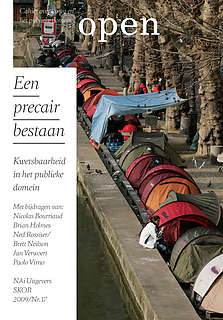
What do you mean by ‘crisis of the unit of measure’?
It is as if the metre, the standard set to measure cognitive and affective experience, no longer works. We see the same crisis in the fields of politics and history: social prosperity is no longer produced by labour time, but by knowledge, by a general knowing, by ‘general intellect’, and as a result social prosperity and labour time are no longer directly connected. The new standard to measure prosperity is within the domain of intelligence, language and collaboration. The problem is that social prosperity is still measured by the old standard of labour time, while realities have changed and it is actually determined by ’general intellect’. We can see the same thing happening in 20th-century art. It demonstrates the inadequacy of the old standards and suggests, in the formal sphere and through the formal work of poetry, new standards for the appraisal of our cognitive and affective experience. This is a point that brought the artistic avant-garde close to the radical social movement and in this sense there is a kind of brotherhood between the two: they would like to explain that the old standards are no longer valid and to look for what might be new standards. Another way to put the problem is: how can you locate a new public sphere, which has nothing to do with the state? Avant-garde art proved the impotence, the inadequacy, the disproportion of the old standards through a formal investigation. The common ground of art and social movements is never about content. Art that relates to social resistance is beside the point, or rather art expressing views on social resistance is not relevant. The radical movement and avant-garde poetry touch on the formal investigation that yields an index of new forms denoting new ways of living and feeling, which results in new standards. All this is far removed from a substantive relation.
So you see only a formal parallel? Do you think there is a historic evolution in this formal parallelism and can there be any interaction between form and content?
No. When it comes to content, there is no common ground. There is only contact with regard to form and the quest for forms. To me, it is purely a matter of a formal investigation. The form of the poem is like the form of a new public sphere, like the structure of a new idea. Looking for forms in the arts is like looking for new standards of what we may regard as society, power, and so on.
As new rules?
Yes, exactly, it’s about new rules. This collapse of the old rules and anticipating new rules, even if only formal, is where aesthetics and social resistance meet: this is the common ground where a new society is anticipated that is based on ‘general intellect’ and not on the sovereignty of the state anymore.
Do you mean: rules to organize the standard?
It is a matter of defining concepts: the concept of power, of work, of activity and so on. In connection with art I would like to add, and this perhaps goes without saying, that after Benjamin we cannot but wonder what the fate of technical ability to reproduce is going to be. In our present context we need, aesthetically and politically, a concept of ‘unicity without the aura’. You both know Benjamin’s concept of the unicity of a work of art involving the ‘aura’, a kind of religious cult surrounding the artwork as is for instance evident in the case of the Mona Lisa. Benjamin points out that the aura is destroyed by reproduction techniques: think about film and photography. The problem we face today is the problem of the singularity of experience, which has nothing to do with aura or cult. To grasp the particularity of the experience we need a concept of unicity without aura, for that particularity or unicity no longer has the character of an aura. Nowadays it is all about finding the relation between the highest possible degree of communality or generality and the highest possible degree of singularity. In art forms, too, what matters is finding the relation between the most general and the most particular. Art is a quest for unicity without any aura.
-- EXCERPT FROM "THE DISMEASURE OF ART: AN INTERVIEW WITH PAOLO VIRNO" BY SONJA LAVAERT AND PASCAL GIELEN FROM OPEN, ISSUE 17, "A PRECARIOUS EXISTENCE: VULNERABILITY IN THE PUBLIC DOMAIN"
